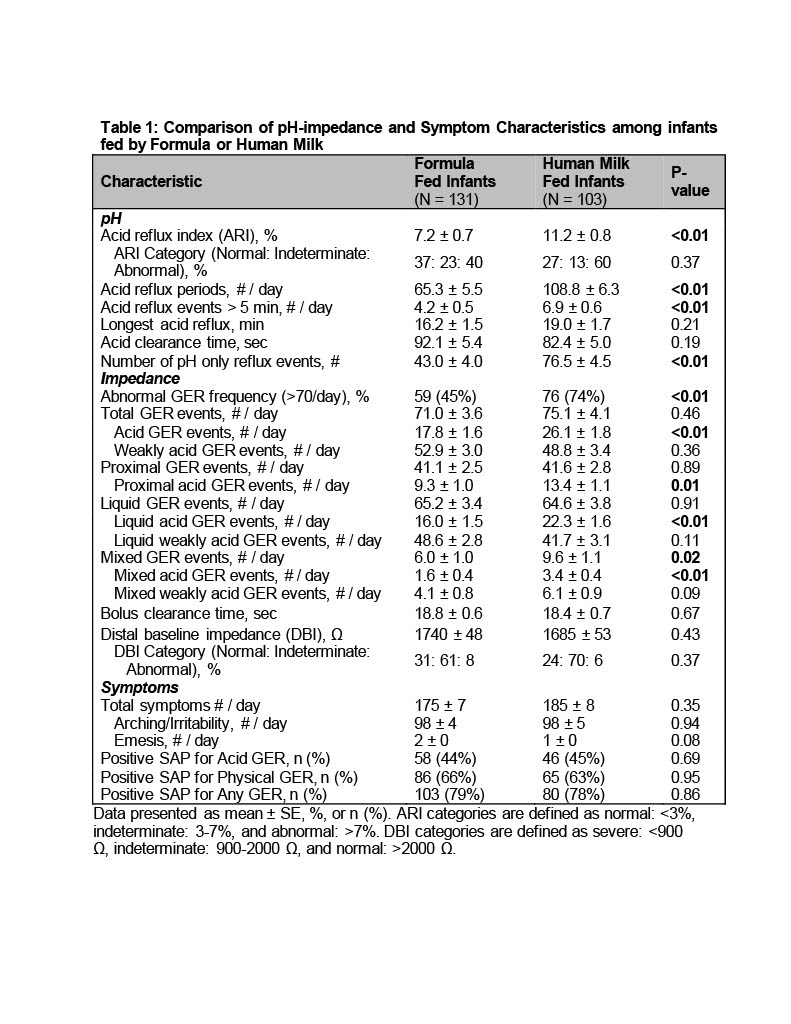Breastfeeding/Human Milk
Breastfeeding/Human Milk 1: Human Milk in the NICU
357 - Characteristics of GER Events in Preterm Infants Fed with Human Milk and Formula are Distinct
Publication Number: 357.101

Erika K. Osborn, MS (she/her/hers)
Neonatal Nurse Practitioner
Nationwide Children's Hospital
Canal Winchester, Ohio, United States
Presenting Author(s)
Background: Prior research has shown that formula fed full-term infants have more frequent and longer episodes of gastroesophageal reflux (GER) than those fed with human milk. It is unknown if this trend is consistent in preterm born infants.
Objective: Aims were to evaluate and compare GER characteristics in formula fed versus human milk fed preterm born infants referred for troublesome symptoms suspected to be due to GER disease (GERD) at full term postmenstrual age.
Design/Methods:
Preterm infants (N=234, born at 29.9 ± 3.4 weeks gestation) were evaluated using 24-hour pH-impedance methods at term status defined as being between 37 - 42 weeks postmenstrual age. The pH-sensor detected acid GER if pH< 4, while impedance sensors detected the physical bolus and proximal extent of GER. These events were analyzed for spatial (proximal extent), temporal (acid/bolus duration in esophagus), physical (gas, liquid, mixed) and chemical (acid, weakly acid), along with esophageal mucosal integrity (distal baseline impedance) characteristics. Frequency of symptoms and symptom associated probability (SAP) were also measured. SAP ≥ 95% indicated a positive symptom correlation with specified GER components. Analysis compared formula fed and human milk fed infants using generalized estimate equation.
Results: Infants were evaluated at 39.6 ± 1.4 weeks postmenstrual age. Comparisons between formula fed and human milk fed infants are detailed in Table 1. Infants fed with human milk had greater acid reflux index (ARI), but no significant difference in symptom frequency, symptom sensitivity, clearance time or distal baseline impedance. Other outcomes in human milk fed vs formula fed, respectively, showed discharge full oral feeding was 77% vs 86% (P=0.3), presence of discharge respiratory support was 31% vs 27% (P=0.5), and length of hospitalization was 63 ± 5 vs 62 ± 4 days (P=0.8).
Conclusion(s): Acid GER events, ARI, spatial and temporal characteristics, and physical and chemical characteristics were all greater in human milk fed infants (compared to formula fed infants). This may be dependent on the characteristics of human milk or human milk modulatory effects on gastric acid secretions. Despite these statistical differences, there were no differences in symptom generation mechanisms or changes in the mucosal permeability marker. Furthermore, there were no significant differences in clinically meaningful discharge outcomes of feeding method, respiratory support, or length of hospital stay. Due to the significant benefits of human milk, it should not be substituted with formula in preterm infants even if they have proven GERD. 
